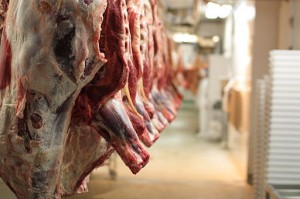On January 10, 1984, Americans first got to see three older women gathered around a seemingly impressive looking hamburger in a fast-food restaurant that proudly proclaimed themselves “The Home of the Big Bun.” After two of them marvel at the size of the bun, one of them lifts up the top of the bun to reveal a little, tiny pickle, a miniscule piece of cheese and a small dot of hamburger. It is at that moment that we initially heard Clara Peller proclaim the line that would echo down the corridors of time:
“Where’s the beef?”
The feisty lady was eighty-one years old when she made that commercial, and I’m sad to report that she is no longer with us. However, if she were still here today, the diminutive Mrs. Peller might be growling a scarier variation of the line that made her famous. I think it would go something like this:
“What’s in the beef?”
 She might also have asked what’s in the chicken, what’s in the turkey, what’s in the pork, and what’s in the lamb, because the meat factories who ship those tempting cuts of protein to your local supermarket are playing with your food to an extent that even boggles the imagination of a somewhat skeptical fellow like me. To make matters worse, in many cases they don’t even have to disclose what chemicals they used in processing the food you serve your family.
She might also have asked what’s in the chicken, what’s in the turkey, what’s in the pork, and what’s in the lamb, because the meat factories who ship those tempting cuts of protein to your local supermarket are playing with your food to an extent that even boggles the imagination of a somewhat skeptical fellow like me. To make matters worse, in many cases they don’t even have to disclose what chemicals they used in processing the food you serve your family.
For instance, how would you like to sample a tasty broth of sulfuric acid, ammonium sulfate, copper sulfate, and water? Odds are pretty good that the poultry sold at your local supermarket has already had the experience. This chemical soup is a government-approved acidifier in poultry processing water. If you’d like to check your recent chicken purchase to see if your Sunday dinner has enjoyed this bath, your efforts will be in vain. Poultry processors don’t have to mention this preparation step, so they don’t bother.
How-To Techniques for Making and Enjoying 100 Sausages at Home…
Another popular acidifier used on poultry and other meats is an “aqueous solution of sulfuric acid and sodium sulfate.” According to the United States Department of Agriculture’s Food Safety and Inspection Service Directive, this tasty solution can be used “directly on meat and poultry surfaces as a spray, wash, or dip.” You’ll never know what method was used on your favorite meat because no one has to tell you about this spray and wash treatment.
In the mood for some potassium hydroxide and sodium hydroxide? You might be able to pick some up in many items that use eggs. They are commonly used to adjust pH in egg products and, once again, no one has to tell you that this tweaking took place.
Other unmentioned substances that the USDA lets meat processors play with while preparing cuts of meat for delivery to your local market include carbon monoxide gas, hydrochloric acid, hydrogen peroxide, methyl polisilicone, ammonium hydroxide, sodium hypochlorite, electrolytically generated hypochlorous acid, chlorine dioxide, and good old-fashioned chlorine gas.
So, why are meat processors using so many scary chemicals?
Well, convenience and profit certainly play their part in the equation, and I’m sure there are some nasty pathogens out there that occasionally need harsh treatment to convince them not to multiply on the long trip from the slaughterhouse to your kitchen table. When push comes to shove, though, the real reason it takes so many caustic and acidic substances to make our meat supply “safe” can be summed up in one simple sentence:
Most of our farm animals are dirty.
At your average industrial farm, feedlot cattle stand around all day long in dirt and manure. Equipped with a digestive system intricately designed to use grasses as food, they are fed corn. This causes the cattle to get fatter quicker, which means they are ready for market sooner. While this might be good for the industrial farm, it is certainly not good for the cattle or for us.
The stomachs of cows and bulls are pH neutral. The consumption of a corn-based diet creates an acidic environment, which sets the stage for a series of disasters. Corn-fed cattle are prone to liver disease, diarrhea, bloat, and ulcers. To top it all off, this unnatural diet also weakens their immune systems. Of course, if you’re running an industrial farm, there is a simple solution to this wide variety of health problems: antibiotics.
Continually pumping antibiotics into your future beef producers keeps them alive long enough to make it to the slaughterhouse at a “healthy” weight. Of course, over time, this practice also leads to the development of antibiotic-resistant bacteria, but we’ll leave that problem for the guys and girls in the lab coats. I’m moderately confident that they’ll come up with some great new antibiotics when all our old ones stop working. How about you?
So now it appears corn-fed beef isn’t such a great idea. Fortunately, the meat department at my shiny supermarket still has poultry, pork, and host of other succulent choices neatly wrapped for my dining pleasure.
Well, to be frank, the news isn’t so good about those choices either. Chickens in industrial farms are usually kept in sheds that contain over 20,000 chickens per shed. Each bird gets a floor space that is just a few inches bigger than their fully grown bodies. Respiratory infections in this environment are common. To make matters just a bit more fun, chickens have this nasty tendency to eat excrement, and they’re not particularly fussy about who delivered this snack. Since they are kept on litter that is rarely, if ever, changed, it comes as little surprise that industrially raised chickens have a host of intestinal problems. Ducks and turkeys are raised in similar fashion in the massive mega-farms. Fortunately, these establishments have stumbled upon a simple solution to the health issues caused by overcrowding. Yes, they also use massive amounts of antibiotics!
The modern industrial farm corporation also raises pigs indoors. Swine receive a bit more space than our feathered friends, but conditions are still dirty and overcrowded. This, of course, leads to a wide variety of health problems which, of course, have a simple solution that begins with the letter “a.”
Looking back on the sentences I’ve put together to make this column possible, it might seem that I’m advocating a vegetarian lifestyle. While I’m certainly a fan of veggies you grow in your very own garden, whether you choose to eat meat or not is a personal choice and, frankly, is none of my business. I am, however, very concerned about the chemicals and antibiotics that being used to get that juicy steak from the cow to a plate at that top-rated restaurant in your neighborhood. I just might need a functional antibiotic one of these days, and I’ll be pretty darn disappointed if the bacteria that are attacking my body have built up an immunity just to make that steak affordable.
The way make this mess a little less serious is to start buying your meat from local farmers that you trust. Insist on grass-fed beef because feeding cattle corn is just stupid. Visit the farm to make sure that the poultry, pig, lambs, and whatever other critter you crave is being raised in humane, sanitary conditions. If you value your health and can’t avoid the meat section of your local supermarket, you should, at the very least, insist on meat that was raised without the use of antibiotics. Yes, you might have to shell out a few more dollars now, but your health and the health of your family is worth it.
©2012 Off the Grid News
 Off The Grid News Better Ideas For Off The Grid Living
Off The Grid News Better Ideas For Off The Grid Living




